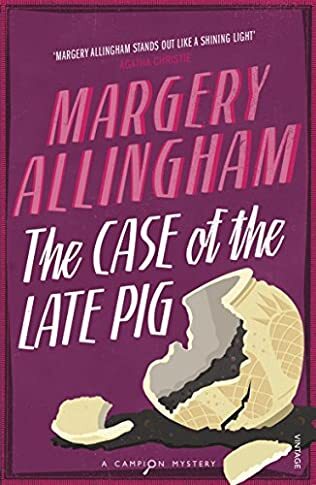The Case Of The Late Pig

A review of The Case of the Late Pig by Margery Allingham
This is the ninth in Allingham’s Albert Campion series, originally published in 1937. It has a couple of unusual features compared with the normal Allingham oeuvres. Firstly, it is written in the first person, Albert Campion himself telling the story with typical sub-Wodehouseian, almost self-effacing humour, never resisting the opportunity to point out his shortcomings in solving the case. It is also a more of a novella than a novel, too long for a short story, but what it may lack in word count it more than makes up in entertainment. It is an amusing and entertaining piece.
Campion’s man servant, the ex-con Magersfontein Lugg plays a prominent part in the story, his repartee with and disdain of his employer’s behaviour always a highlight of an Allingham story. Lugg’s disappearance brings the tale to a dramatic conclusion, an event foreshadowed in the opening paragraph when Campion notes “I was pretty nearly brilliant in it in spite of the fact that I so nearly got myself and old Lugg that I hear a harp quintet whenever I consider it”.
The Late Pig in the title is R I Peters, also known as Pig Peters and Roly Peters, an old school friend in the loosest sense of the word as he was an odious bully, to whose funeral Campion had promised to go when the grim reaper called. Unusually, the grim reaper calls for Peters twice. At the start of the book Lugg reads out Peters’ funeral notice in The Times while Campion is perusing an anonymous and enigmatic letter he has been sent. The funeral is sparsely attended, the victim having succumbed to pneumonia.
Around five months later Campion receives a phone call from a Chief Constable, telling him of a murder at a hotel run by Poppy Burridge in Kepesake. The victim was struck on the head by an urn which fell from the hotel roof while he was sunbathing. The victim is named as Oswald Harris who had just got his hands on the hotel and had plans to build a cinema and race track. When Campion views the body, he is surprised to find that it looks uncommonly like Peters. How could have Peters dies twice? Why was he killed and by whom and why was he masquerading as Harris?
All the guests at the hotel have alibis except for a newcomer, Hayhoe, who was seen with Harris, making him the prime suspect. Another of Campion’s schoolfriends, Whippet, flits in and out of the story and they both receive more anonymous letters which seem to indicate that a mole is central to unlocking the mystery. The body disappears and subsequently found in the river, a vicar is drenched and the doctor takes a more than passing interest in proceedings. When an attempt is made on the lives of both Campion and Lugg, all becomes clear to the amateur sleuth and the tale ends with a thrilling denouement.
This story is fairly clued as to the identity of the culprit, although the motivation is not overly apparent. It is a tale of identity, insurance fraud and greed. Thieves always fall out and the overriding conclusion is that one should be careful who you choose as school friends.
Allingham writes with considerable verve and it is an entertaining, amusing, fast moving tale which is sure to delight those who appreciate their crime fiction laced with humour.



